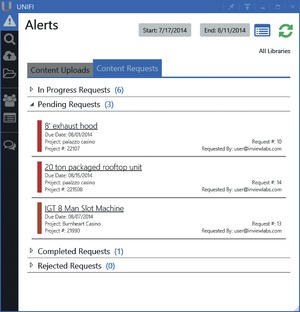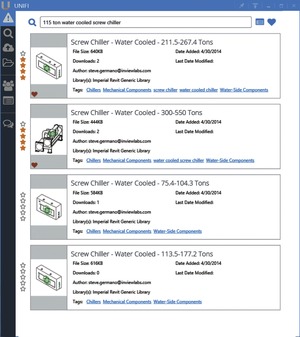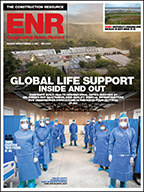

A cloud-based building-information-modeling management service is leveraging advanced search and metadata tagging functionality to super-charge how teams manage project assets.
The subscription service by start-up Unifi currently handles only Autodesk Revit files on its platform, with support for Trimble Sketchup files expected later this year. The company says the platform works like this: By dragging your entire library folder structure into Unifi, the application automatically tags each piece of content with metadata and a folder name, which makes the content easier to find.
"There are other data asset- management platforms, but they're like having a Dropbox account. You can search only by file name," says Stephen Germano, director for Unifi, which is owned by technology consulting firm INVIEWlabs, Las Vegas. "This is the first program that can search BIM like Google," he adds. After Unifi extracts and indexes metadata from all the Revit or Sketchup models, users then can search their libraries by asset type and description, instead of by file names alone.
Germano says that, for a given piece of equipment, the power rating, voltage, static pressure and physics metadata comprising a manufacturing spec sheet are uploaded to the Unifi cloud, along with the BIM file.
"We can even translate data from one sort of metric to the next," says Germano. If designers put a length parameter in a Revit family, it will turn up whether metric or imperial units were queried. For example, a search for a 2-in.-long section of pipe or a 5.08-centimeter-long pipe will turn up the same section of pipe. Unifi also checks newly added files against existing content to avoid duplicate uploads.
The search function deploys a heuristic algorithm so that it can use relevancy to adapt search results over time.
"It has really helped us to centralize content as well as make it easier for the end user to find the information they need, faster," says John Travis Yates, BIM specialist at MulvannyG2Architecture. The Portland, Ore.-based company started beta-testing Unifi in 2012 and is now one of its subscribers.
Yates says that, previous to Unifi, his team would have to search through folders or ask people where files were located. Now, they search using only keywords or the name of the item.
In addition to an advanced version of desktop search, the Unifi platform handles users and permissions, allowing BIM files to be shared inside and outside a domain. Whenever new files are added to a company's library, administrators get an alert that the files are pending quality-assurance review. The company says it deploys armed security at its hosting facility and requires biometric ID to enter its data centers; further, all communications between Unifi clients and the server stack are SSL-encrypted. Unifi automatically upgrades Revit files, too. To address version control, Unifi automatically will create the latest versions of Revit, so there is a single point of truth for each file, adds Germano.
Germano says he noticed the need for smart BIM searches in 2006, when he was a BIM manager for a 500-person MEP firm.
"All of the BIM communities online were talking about doing this," says Germano. "So, I built my own ugly, simplistic interface to search through the database and find content."
Unifi went through many renditions and updates since its launch and now counts some 80 customers following its official release last April. Over three years, firms such as Gensler, HKS and AECOM were beta-testers.
The introductory price is $12 per seat, per month, says Germano. "Designers save two to four hours a week in work. It pays for itself pretty quickly," he notes.
Yates says these numbers depend on how much a firm needs the software and the size of the project, but affirms that, on a typical project, his designers save a couple of hours a week.
"This will easily grow when we start updating our content to include the system families and other information we can place into it," says Yates.



Post a comment to this article
Report Abusive Comment